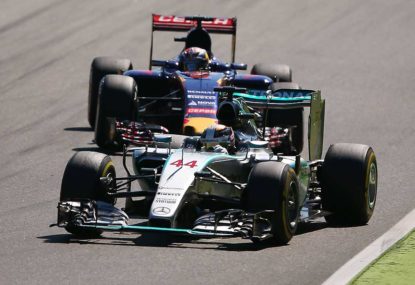Huge shake-up at Team Arrow McLaren for the rest of the IndyCar season: Pourchaire in, Malukas out
Theo Pourchaire replaces David Malukas, who got injured and then fired before he could even sit in the car.

It should have been a straightforward weekend for the championship team in waiting, but Mercedes’ off-track antics have tarnished their performance at the Italian Grand Prix.
In a race marred at first by the spectacular engine failure aboard Nico Rosberg’s car, Lewis Hamilton’s victory, which has him primed to claim his second successive title for Mercedes, was in dispute for twice as long as the total race time, after the chequered flag fell for an alleged breach of tyre usage guidelines.
Both misfortunes – though Mercedes escaped bafflingly scot-free from the latter because the breach fell in an inexplicable grey area of the rules – were the making of decisions that could have cost Mercedes a (larger) haul of points and put the title race back to the relative closeness of the pre-Belgium standings.
First things first: Mercedes’ pace at Monza was dominant, thanks in part to an upgraded power unit. Ferrari, to their credit, brought their own new power unit iteration, and though their new model gained ground even on Mercedes’ latest offering, it was not enough for Monza, where raw power is king.
It was unfortunate for Rosberg, then, who had to contend for the podium with an old-spec engine with five races on the odometer after the German’s car developed a chassis problem that made the new power unit unusable.
The decision to use an old unit rather than new one is understandable given that a new old-specification power unit would have been his fourth total power unit of the season, meaning when he did get around to bolting a new-spec unit in his car later in the season – likely at the next round in Singapore, where overtaking is notoriously difficult – it would be his fifth for the season, earning him a grid penalty.
Backing up the decision was that Mercedes’ power units, when installed in Mercedes’ own cars, have had bullet-proof reliability this season, and the power unit in question had powered Rosberg to four podiums, including a victory, since its introduction at the Canadian Grand Prix.
He qualified fourth on Saturday, and was set salvage third at a minimum – Sebastian Vettel looked comfortable enough in second to hold his compatriot back, keeping him at bay by more than two seconds at all times. That is, until the final lap of Rosberg’s race.
Mercedes threw caution to the wind and had the German turn his engine up into a higher performance mode. Then it blew up.
The difference between second and third is three points – just three points ceded to Hamilton in the title fight. Vettel was 39 points behind Rosberg and 67 points behind Hamilton going into the Italian weekend, so was never really a threat to either of them. The risk was hardly worth the backfire.
The story is similar for the team’s engineers, who were hauled before the stewards after the race to answer for allegedly illegally low tyre pressures on both of the team’s cars prior to the race start. The readings taken by Pirelli reported that pressure in the left-rear tyre were 0.3 and 1.1 pounds per square inch lower in Hamilton’s and Rosberg’s cars respectively.
Mercedes successfully argued that the regulations regarding at what point during the race the tyres had to meet a certain minimum are sufficiently vague and escaped without charge. The likely penalty would have been disqualification.
Controversy over the decision aside – and controversial it definitely is – Mercedes played a game of unnecessary risk. They deliberately kept tyres at the lowest possible pressure in full knowledge that any slight unforeseen variation in process could have had it thrown out of the race, regardless of the fact their cars clearly had enough pace in hand to work around something as minor as marginally higher than preferable tyre pressure.
On the one hand you can respect that Mercedes continues to push hard this season, despite the near inevitability of claiming another set of championships. Formula One has always been about pushing the envelope in pursuit of performance.
But on the other hand motor sport is a numbers game. Knowing as they did that Rosberg’s engine was already at the end of its life, knowing that Pirelli was strictly enforcing the usage guidelines, their equation for what constituted a calculated risk should have changed. It didn’t, and they paid 50 per cent of what could have – and quite possibly should have – been a hefty price for misjudgement.
Will Mercedes’ luck last for the rest of the season?